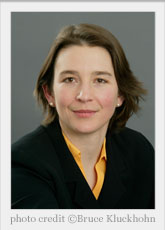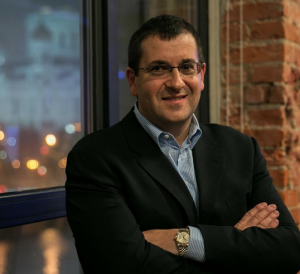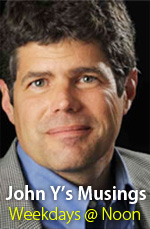By Saul Kaplan, on Mon Aug 18, 2014 at 8:30 AM ET  I would like to go to the new $1.2 billion Cowboys Stadium in Texas to watch the movie The Matrix. I have no interest in watching a football game there. Full disclosure, I have never liked the Dallas Cowboys. I think it has something to do with a mean cousin who loved them and harassed me about it in grade school. I would like to go to the new $1.2 billion Cowboys Stadium in Texas to watch the movie The Matrix. I have no interest in watching a football game there. Full disclosure, I have never liked the Dallas Cowboys. I think it has something to do with a mean cousin who loved them and harassed me about it in grade school.
In a classic egomaniacal move Cowboy’s owner Jerry Jones ordered a ginormous jumbotron that hangs 90 ft above the playing field spanning from one twenty yard line to the other, right in the likely flight path of many punts.
How big is this oversized HDTV? Its display screens are 159 by 72 feet and it weighs 432 tons. Talk about surround sound.
And talk about a design flaw. Their user experience expert must have been so focused on delivering an incredible experience for the fans attending the game that they completely forgot that the stadium was going to host actual football games.
How big a design error is this? You judge.
Christopher Moore, an Assistant Professor of Physics at Longwood University in Farmville, VA, blogged about the physics of punting on ilovephysics.com:
” A study in 1985 of 238 punts made by 24 different NFL punters found that punters typically don’t punt for maximum distance, but to balance distance with hang time. The study found that on average, NFL punters kick the ball at an angle of 57 degrees with an average speed of 60 mph. With these parameters, a NFL punt would have an average height of about 90 feet, which is exactly the height off the ground of the Cowboy’s scoreboard. Air resistance would probably decrease this number 10-15%, though. More important, though, were parameters for “elite” kicks. An elite kicker can boot the ball with speeds up to 70 mph. At the same average angle, that results in a height over 120 feet.”
The physics of kicking a football suggest that the jumbotron will be hit a lot. This is a huge design screw up and Jerry Jones should be forced to move the HDTV screen into his home where I am sure it would easily fit without getting in the way.
But no, this is the NFL where team owners rule the roost. Jerry Jones petitioned (probably more like told) NFL Commissioner Roger Goodell that a new rule would have to be created to accommodate punts that will inevitably hit the video screen. And it was done. The NFL announced the following new rule:
“If a ball in play strikes a video board, guide wire, sky cam or any other object, the ball will be dead immediately, and the down will be replayed at the previous spot”
That the rule will come into play is no longer hypothetical. In the third quarter of the first exhibition game played in the new venue between the Cowboys and the Titans, the backup punter for Tennessee, A.J. Trapasso, hit the jumbotron squarely and the ball bounced straight down. The punt was ruled dead and the down replayed.
During warm-ups before the game Trapasso had hit the screen monstrosity three times and the Titan’s starting punter, Craig Hentrich had nailed it a dozen times.
You would think they could have figured this out during the design process. There is no room for ego in good design and I still don’t like the Dallas Cowboys.
By Matt Ranen, on Thu Aug 14, 2014 at 1:30 PM ET  Public debates about policy often focus on trying to explain why a particular approach will make the ‘whole system’ work better. Consider Obamacare: it’s supposed to insure the uninsured, improve the quality of care, and ‘bend the cost curve’ to reduce the costs. Or Education reform: the online MOOC is supposed to radically reduce the costs of education while scaling the very best teachers by orders of magnitude. It’s become almost a necessity of public debate—at least in the US—to assert that a big idea reform proposal is a ‘win-win.’ And to stand in opposition to this best-of-all possible worlds means you are either too dumb to understand or simply dishonest. Public debates about policy often focus on trying to explain why a particular approach will make the ‘whole system’ work better. Consider Obamacare: it’s supposed to insure the uninsured, improve the quality of care, and ‘bend the cost curve’ to reduce the costs. Or Education reform: the online MOOC is supposed to radically reduce the costs of education while scaling the very best teachers by orders of magnitude. It’s become almost a necessity of public debate—at least in the US—to assert that a big idea reform proposal is a ‘win-win.’ And to stand in opposition to this best-of-all possible worlds means you are either too dumb to understand or simply dishonest.
Would that it were so. This kind of thinking can be popular on the surface and it certainly makes for ‘provocative’ op-eds that garner lots of hits on newspaper websites. But it doesn’t serve the public interest, isn’t good for business-government relations, and is not a good way to work with other stakeholders that will have to be involved. Ironically, it gets in the way of both the technical and social innovation it is trying to foster.
Here’s why. Almost every big public policy debate is ultimately an argument about the aspirations and visions we have and how we want our society to ‘look’. Implicit in this is a decision about the tradeoffs we are willing to make to get there and the effective winners and losers of policy decisions. The win-win discourse tries to push what are in fact deep disagreements about this into the background where no one has to look too closely.
We get the motivation. It’s certainly comforting and easier to claim that everyone can have better, cheaper healthcare distributed more fairly and no one will lose anything in the process. But look beneath the hood and the supposed cost savings in the short and medium term depend heavily on cutting Medicare reimbursements to doctors. And that doesn’t happen: every year, like clockwork, Congress postpones those cuts. So we don’t actually face the trade-offs, but rather, push them off into some unspecified future.
Or elsewhere, in the current debate over Internet traffic rules: it’s much easier to assert that net neutrality makes the Internet better on all dimensions—more open, more free, more secure, speedier, and more fair to newcomers—until someone points out that they didn’t have sufficient bandwidth to get the SuperBowl on their iPad, watch the opening episode of Game of Thrones without disruption, or get high quality FaceTime streaming with their grandma, even though they paid for this. If only we could have our broadband cake and eat it too.
It takes courage on the part of business leaders and public policy makers to put these kinds of trade-offs in the foreground. But here’s the twist — we think this would actually be very good news for innovation. Figuring out how to compensate or reduce the pain to losers is actually one of the most significant drivers of innovation because it forces real choices from which new value springs. If Comcast is simply evil and Google is simply good, then it feels like a win-win to force Comcast into being a dumb pipe for Google content. But dumb pipe companies won’t (indeed, can’t) invest very much in new infrastructure and new services. So a better solution might also include incentives or requirements for the ‘good’ companies to deliver their content and services with radically greater efficiency: using 1/10 or 1/100 of today’s bandwidth—which in turn would open up the remainder for new applications from brand new content innovators.
Putting trade-offs in the foreground doesn’t offer the cheap thrill of demonizing certain companies in the ecosystem — the health insurers, the broadband providers, the for-profit education companies, and so on. But it’s more honest and ultimately better for innovation and growth. And it may actually lead to a more stable profit margin over the long run for those companies who are wise enough to not create a desperate, and possibly angry, set of losers later on.
By Brooke Masters, on Tue Aug 12, 2014 at 1:30 PM ET  Slowly, ever so slowly, banks are being forced to clear away the fog and mirrors that have protected their balance sheets from the prying eyes of investors and sceptics. Slowly, ever so slowly, banks are being forced to clear away the fog and mirrors that have protected their balance sheets from the prying eyes of investors and sceptics.
Last month, UK banks became the first in the world to disclose their total borrowing, known as leverage ratio, on a standardised basis.
They haven’t done this willingly – the Bank of England insisted – and their disclosures are all surrounded by lots of hemming and hawing about how the leverage rules are still changing.
The results are instructive. The UK’s five biggest banks are considered among the best capitalised in Europe on the traditional measure of core tier one equity divided by risk-weighted assets, which includes everything from home mortgages and small business loans to complex derivative contracts, each multiplied by a factor intended to reflect the amount the bank could lose. The ratios range from 12.3 per cent at HSBC down to 10.3 per cent at Royal Bank of Scotland.
The disclosed leverage ratios strip out the effect of risk modelling, which has the effect of more than doubling the size of every bank’s balance sheet and more than tripling that of Barclays. These numbers partly reflect the size of low-risk, high volume businesses. But they will be a boon to critics who think some banks have been tweaking their models to cut their capital requirements.
Read the rest of…
Brooke Masters: The Leverage Story Banks Want to Hide
By David Goldberg, on Mon Aug 11, 2014 at 1:30 PM ET “He’s got pretty persuasion. She’s got pretty persuasion. Goddamn, your confusion.” Pretty Persuasion – REM
 Interviews can be deceiving and confusing. When you meet a candidate in person, you can get a lot of false positives. The candidate is on her best behavior, well prepped and aiming to sell you on herself as a great hire. Often, you will find yourself enjoying your conversation enough that you get persuaded to hire someone who really isn’t the right fit for the role. That is why I believe interviews are for weeding people out but real references are the best barometer for making a job offer. I have learned this through years of experience and mistakes. My friend Thomas Layton, the former CEO of OpenTable and current Chairman of Odesk, helped me confirm this approach when I started at SurveyMonkey in 2009. Interviews can be deceiving and confusing. When you meet a candidate in person, you can get a lot of false positives. The candidate is on her best behavior, well prepped and aiming to sell you on herself as a great hire. Often, you will find yourself enjoying your conversation enough that you get persuaded to hire someone who really isn’t the right fit for the role. That is why I believe interviews are for weeding people out but real references are the best barometer for making a job offer. I have learned this through years of experience and mistakes. My friend Thomas Layton, the former CEO of OpenTable and current Chairman of Odesk, helped me confirm this approach when I started at SurveyMonkey in 2009.
 In my early days at SurveyMonkey, 100 percent of my time was spent on HR-related issues, specifically recruiting. At the time, SurveyMonkey was 14 people in Portland– my first priority was to scale the team. From a small office in Menlo Park, California, I had to find and hire talent. I had to interview everyone personally and make most of the decisions myself. In my early days at SurveyMonkey, 100 percent of my time was spent on HR-related issues, specifically recruiting. At the time, SurveyMonkey was 14 people in Portland– my first priority was to scale the team. From a small office in Menlo Park, California, I had to find and hire talent. I had to interview everyone personally and make most of the decisions myself.
This meant tracking down and calling real references – a job most delegate to HR. I don’t think you learn much from references listed by the applicant. Those people are clearly going to say good things. You need to get real information from someone who you trust. Most of the people we hired in the beginning were two degrees away- that is, they were referred or connected to someone I knew. This allowed for honest feedback on the candidate’s strengths and weaknesses. If we didn’t have that direct reference to talk to, I used LinkedIn to find people who had worked with the person. Each role was different but some things were universal. I needed people who could flourish in a startup like culture but could also understand how to scale. Would he be willing to do his own work or did he just view his role as a manager, telling others what to do? How did she solve scale problems when they occurred? You can ask candidates those questions but it is much more valuable to understand how the person actually behaved in real situations.
Cultural fit is also important and impossible to figure out in an hour interview. How does the person work with peers, manage people and deal with stress? You can ask your real reference those questions; get past the “pretty persuasion” of the interview. I learned the hard way that someone who looks great on paper may not fit with our culture. Their experience simply didn’t carry over to their job with us. It turns out that people with seemingly relevant experience just are not interchangeable. A person who was an all-star at one company might not be able to repeat that performance in your organization, because his success may have derived from relationships with the previous employer, or her team may have propelled her achievement.
On the other hand, many people may not have the experience you feel is required for a job, but are just really smart, talented and motivated. When you take a chance on these employees and get it right, they become home grown talent – essentially your farm team. These are likely to be the carriers of your culture, and some of the best, most loyal employees because you took a chance and developed them from within. I have found it has worked to have a mix of experience and raw talent- the two types learn from each other.
At SurveyMonkey, we’ve moved talented people within the organization to give them room to stretch and grow — finance folks to business development roles, customer ops to engineering. It is much easier to take a chance on someone who already has proven themselves for you in another role than bring an experienced outsider in- the internal hire has all the boxes checked except experience.
As the company has grown, my time spent on HR-related matters has shrunk. Still, nearly one-third of my responsibilities relate to talent and culture. We are a company that defines success by getting and keeping the right people. I still do my own calls for all key hires and look for good spots to build that farm team of great talent. Let resumes and interviews be used to reject candidates but rely on real references to hire people.
By Saul Kaplan, on Mon Aug 11, 2014 at 8:30 AM ET  Irwin Kula is an eighth-generation rabbi known for his fearless attitude about change — a rare quality among religious leaders who tend to adhere closely to tradition. Irwin Kula is an eighth-generation rabbi known for his fearless attitude about change — a rare quality among religious leaders who tend to adhere closely to tradition.
Kula, president of the National Jewish Center for Learning and Leadership (CLAL) in New York and the author of Yearnings: Embracing the Sacred Messiness of Life, has dedicated himself to opening up the wisdom of his 3,500-year-old faith to be in conversation with the world.
Kula preaches the “highest possible institutional barriers between church and state,” with the “lowest possible communication barriers.” He welcomes intermarriage and interfaith dialogue. He recognizes God not as a “Seeing Eye,” but in “experiences of love, caring, and connection.”
Many consider Kula progressive; others, disruptive. But Kula maintains that institutionalized disruption is essential to adaptation and growth.
Rabbi Kula looks like the wise man of children’s books. He has a handsome widow’s peak, and speaks with homiletic pauses and animated hands. When asked about how his beliefs developed, he answers in stories.
At 14, Kula was thrown out of the private parochial school he attended for challenging the Torah. “I would ask a class of 25 students questions which were probably a touch ‘teenagerish’,” he recalls. “I’d ask, ‘You don’t really believe this — God splitting seas? Come on, this is not what this is actually saying’.”
This rebellious streak would come to define his practice.
The problem with most religious leadership, Kula claims, is that its mission is to convert the non-affiliated. “Religion is not about creed, dogma, or tribe,” he counters. “We need to stop judging our success by membership dues — this isn’t about how many hits. First and foremost, religion is a toolbox designed to help human beings flourish.”
Kula claims that he finds himself often at odds with the concept of “God” as commonly invoked in the American public arena. To him, this is the God of touchdowns and wars, an intervening God who “casts out” unless one “buys in.” “No religious or political system has a hold on being moral,” Kula says. “Systems are only as good as their people.”
For most of his rabbinic appointment, Kula kept these views to himself. Only after the September 11 attacks did he begin to more openly preach what he himself practiced.
“I was very unnerved, knowing the religious impulse compelled that,” Kula says. After the tragedy, he shut down his teaching for three months to reevaluate his role as a spiritual leader. When he returned to the synagogue, he had made the decision “never to teach Judaism again simply to affirm the group’s identity.”
In 2013, Irwin Kula recounted the narrative of his spiritual conversion to a packed theatre of global business leaders at the Collaborative Innovation Summit, an event hosted annually by the nonprofit Business Innovation Factory (BIF) in Providence, RI. On stage, the rabbi made an ambitious appeal to his audience, whom he knew to be composed of astute tinkerers and serial entrepreneurs: He asked them to join him in his mission to innovate religion.
Kula is a fervent believer in accessing insight beyond the religious tradition. “It’s really important to speak to non-incumbents,” he maintains. “The less you speak exclusively to your own ‘users,’ the better shot you have of keeping your own practices from becoming incredibly distorted.” His CLAL runs a program called Rabbis Without Borders, dedicated to fostering open dialogue across cultural and religious barriers.
Stories of innovation often feature “two kids in a garage.” Kula’s goal has been to tell an innovation story from the cathedral. “Religion’s just a technology,” his BIF talk began. “How the hardware of humanity gets used will depend on the software.”
His talk covered how the rapid advancements of the digital infrastructure age demand that we broaden our ethical horizons: What are the new crimes? In this new order, who is included and what are their rights? As we redefine morality, the need to innovate faith becomes especially pressing.
“The most interesting businesses ask ‘impact on society’ questions, which are more complex than ‘killer app success’ questions,” Kula reflects in hindsight. “At BIF, I asked, ‘What would happen if we applied innovation theory to religion, to compress the resources it takes to create good people?’”
Kula looks forward to returning for BIF10 in September.
“If a homily is 15 minutes in church, it’s 18 minutes at BIF,” he says. “As conferences go, BIF embodies total equality between the storytellers and their audience. In many ways, it’s the best of what a spiritual community is — we’ve got to bottle that.”
This is the second of a 10-article series of conversations published on the Time website, authored by myself and Nicha Ratana, with transformational leaders who will be storytellers at the BIF10 Collaborative Innovation Summit in Providence, RI, on Sept. 17-18.
By Saul Kaplan, on Mon Aug 4, 2014 at 8:30 AM ET  John Hagel speaks with satisfying precision. He has kind eyes and stern glasses, which together dominate the screen during a Sunday-afternoon Skype conversation. John Hagel speaks with satisfying precision. He has kind eyes and stern glasses, which together dominate the screen during a Sunday-afternoon Skype conversation.
As co-chairman of Deloitte’s Center for the Edge, Hagel hunts for unexploited capability on the “edges” of business and makes the case to include them on the CEO’s agenda. “The edges are most fertile areas for innovation,” he says. They are an important place to watch, because what happens at the edges transforms the core.
Hagel’s research encompasses geographic edges (overseas economies), demographic edges (younger generations entering the workforce, their unmet needs), and the edges of technological discovery. If there’s anything his work has taught him, it’s that the manual is less of an asset than the “ability to respond to unexpected events.”
Hagel believes that we are approaching fundamental revaluation of the role corporations play in our lives.
Corporations in the first half of the 20th century were built around what Hagel calls the “push” business model. The greatest asset of these vertically integrated, gargantuan structures was their knowledge stock — aggressively protected trade facts and formulas that allowed them to forecast with reasonable accuracy which direction to “push” operations.
However, this push model is failing in the face of expanding digital technology infrastructures, Hagel claims. Reinforced by long-term policy shifts toward economic liberalization, barriers to market entry have been significantly reduced on a global scale. The pace of our transactions has increased, the lifespan of knowledge stocks has decreased and competitive intensity in the US economy has doubled in the last 40 years. Hagel calls this “the dark side of technology” — a counter-narrative to the Silicon Valley script of dazzling possibility.
But Hagel sees an antidote to this volatility: openness. “People are realizing that they need to collaborate to survive,” he says, “You have to give up your secrets, your competitive advantage. It’s the only sustainable edge.” Hagel calls this new order the world of “pull,” and he describes it in his book, The Power of Pull: How Small Moves, Smartly Made, Can Set Big Things in Motion.
“Pull,” a splendidly iconoclastic antidote to traditional American corporate culture, means moving away from hub-and-spoke networks where knowledge was selfishly guarded to mesh networks that favor collaboration. Pull rejects claims to have all the right answers and instead favors asking smart questions.
“When people come at you with a façade as if everything’s under control, it does not generate trust,” Hagel says. “Admitting you don’t know something is a prerequisite to making progress.”
Rather than showing strength, influence in an uncertain economy paradoxically comes from expressing vulnerability. Yet Hagel says he had to learn the value of vulnerability. As a boy, he was often subject to his mother’s hostile temper.
“The key lesson that I took from my childhood was that my needs did not matter,” he explains. Upon his entry into management consulting, Hagel readily embraced the maxim that the client’s needs had to come first. “For the first part of my career, I was a servant of others,” he says. “The idea that others could help me was completely foreign to me.”
Hagel attributes the shift in his thinking to a talk he gave at the Collaborative Innovation Summit hosted annually by the nonprofit Business Innovation Factory (BIF) in Providence, RI.
“Saul Kaplan invited me to be a storyteller at BIF6, and I’ve talked a lot and in various conferences and settings, and that seemed perfectly fine,” Hagel says. “But then he said, ‘We want you to talk about a personal experience and what you’ve learned from it,’ — and that was very scary.”
“Stories are not my thing. I am a person of reason and analysis,” began Hagel’s BIF6 story. But sure enough, he shared two tales of formative childhood experiences in a passionate expression of his business philosophy that later became the story of that year’s Summit. “It was the first time I ever got on stage and talked about myself,” he reflected in hindsight.
The experience was an incredible catalyst. “It really unleashed a tremendous sense of potential and possibility, that by sharing my personal experiences, by talking about things I didn’t know, and I connected with people in a way that I would never have had I just given my standard speech. I can’t wait to be a storyteller at BIF10 in September.”
“The key lesson I got from the BIF Collaborative Innovation Summit,” Hagel says, “is that innovation is ultimately not about ideas, it is about personal connection.”
This is the first of a 10-article series originally published on the Time website, authored by myself and Nicha Ratana, of conversations with transformational leaders who will be storytellers at the BIF10 Collaborative Innovation Summit in Providence, RI, on Sept. 17-18.
By John Y. Brown III, on Fri Aug 1, 2014 at 12:00 PM ET  Have a failed marketing campaign? Are you still, after attempting multiple promotional strategies, still struggling to break through? Have a failed marketing campaign? Are you still, after attempting multiple promotional strategies, still struggling to break through?
Here is one of my father’s favorite explanations. Mine too.
Maybe the dogs don’t like it:
Once upon a time a pet food company created a new variety of dog food and rolled out a massive marketing campaign to introduce the product. Despite hiring a first-rate ad…vertising agency, initial sales were very disappointing. The agency was fired and a new agency and a new campaign was launched. Sales continued to disappoint. If anything, they fell even further. In desperation, the CEO called in all of the top executives for a brainstorming session to analyze what had gone wrong with the two campaigns and how a new campaign might revive sales.
The meeting went on for hours. Sophisticated statistical analysis was brought to bear on the problem. One VP argued that the mix of TV and print ads had been messed up. Another argued that the previous campaigns had been too subtle and had failed to feature the product with sufficient prominence. Another argued that the TV ad campaign had focused too much on spots during sporting events and not enough on regular programming with a broader demographic. Another argued the opposite–not enough sports programming had been targeted. After the debate had raged for hours, the CEO felt they had accomplished very little. He asked if anyone else had any theories that might explain the failure of the new product. Finally, one newly hired employee raised his hand and was recognized.
“Maybe the dogs don’t like it,” she said.
By Jason Grill, on Tue Jul 29, 2014 at 2:00 PM ET From ThisisKC.com:
Superstar Service: JGrill Media
Whether he’s interviewing local innovators on KMBZ’s “Entrepreneur KC” radio show, writing a piece for The Huffington Post explaining why our burgeoning Midwestern tech hub is “not flyover country,” or helping a tech firm gain exposure through his PR firm JGrill Media, Jason Grill is your quintessential Kansas Citian who keeps his hometown close to his heart.
Through a unique combination of media and government relations, business consulting, and local and national commentary, JGrill Media helps establish mutually beneficial relationships among key players in the community that all want the same thing: “To make Kansas City the best to place to live and do business,” Grill says.
“Whether you need advice, are looking for capital or want to meet with someone at the Kauffman Foundation, people here have a vested interest in seeing other entrepreneurs succeed and will actually help you build your business while building their own,” he continues. “There’s a Midwestern value here that believes that strengthening the community is very important.”

Building relationships and making introductions is one of the key ways Grill does his part. Although he “never would have guessed” he’d someday have his own company—or rather companies, plural, since he’s also one of the owners and cofounders of Sock 101—JGrill Media is basically the culmination of Grill’s illustrious career as an attorney, author, adjunct professor, entrepreneur, political advisor, media correspondent and two-term Missouri state representative.
“I’ve always liked media, politics and connecting people, and all of those things are important for what I do now,” Grill says. “I know who the players are, how to get meetings set up and how to interact with the media. Being a legislator taught me how to campaign and how to fundraise. And as a business owner and startup co-founder, I understand the needs of young companies from a relationship, media and growth perspective.”
Drawing upon his eclectic background, business savvy, legal knowledge and strategic media approach, Grill has a seemingly effortless knack for fostering partnerships that not only help his clients grow and get noticed, but solidifies his own position as a superstar in the community.
His contagious optimism and unwavering civic pride only fuel his popularity. “I just like talking to people and building relationships,” Grill admits. “It keeps you sharp and helps you grow as a person so you can build more relationships.”
It’s hard to predict what this serial entrepreneur will do next. “I don’t think I’ll ever settle into one role,” Grill says. “When I was a kid, I wanted to be a football player one year, and then the next year, I wanted to be a baseball player. I think that’s the nature of being an entrepreneur. And I think that’s what makes JGrill Media unique because it works in different verticals to provide services that no other affordable and hands-on KC company can provide.”
– Kathryn Jones
By Brooke Masters, on Tue Jul 29, 2014 at 1:30 PM ET  Banking union is the flavour of the month. Faced with investors who doubt the ability of some eurozone sovereigns to make good on their debts, the 17 members of the single currency have agreed to work together to channel aid directly to troubled lenders. But the deal is conditioned on the creation of a single banking supervisor, empowered to crack down on risky banks, no matter where they are located. Banking union is the flavour of the month. Faced with investors who doubt the ability of some eurozone sovereigns to make good on their debts, the 17 members of the single currency have agreed to work together to channel aid directly to troubled lenders. But the deal is conditioned on the creation of a single banking supervisor, empowered to crack down on risky banks, no matter where they are located.
Setting up an impartial expert to oversee the banks could well be a key step toward restoring trust. Freed from local political concerns, a central supervisor might well have a clearer view of the problems and the fortitude to take the almost certainly unpleasant decisions needed to solve them.
But well-informed banking supervisors can’t be summoned with the wave of a wand, and key eurozone finance ministers this week repeated calls for something to be put in place by the end of the year. Given that tight deadline, the options are pretty limited. The fledgling European Banking Authority, which opened its doors just over 18 months ago, currently sets standards but it has no legal authority to supervise banks. Its mandate to create a stable and level playing field throughout the single market also runs counter to taking on a specific eurozone role.
The European Central Bank is seen by many as the only operator with the credibility and resources to crack down hard on recalcitrant lenders. The current plan is for the ECB – or some offshoot – to take charge of the bigger, cross-border institutions while smaller banks would continue to be supervised locally. That arrangement – which parallels the UK plan to hand supervision back to the Bank of England next year – raises concerns about an overly powerful central bank trying to do too many jobs at once. It also contains a problematic fudge. Small banks can be dangerous too. Witness the woes of the Spanish regional savings banks and the 2007 depositor run on Northern Rock, a middle-sized UK lender.
Read the rest of…
Brooke Masters: On-site supervisors a good start for ECB
By John Y. Brown III, on Tue Jul 29, 2014 at 12:00 PM ET  You know, maybe…. learning to play with building blocks is the most important activity we learn as children. You know, maybe…. learning to play with building blocks is the most important activity we learn as children.
Because we continue– metaphorically speaking–to play this game our entire lives.
Everytime we experience something new or learn some new piece of information or glean some new insight about life it is like we collect a new block we can play with–to help build something with.
So, I guess we should ask ourselves each day, “What are we building today with our building blocks?” And, “Which building blocks are we choosing to build with?”
 == ==
Success milemarkers for a new business.
The day you replace the two chairs in the entrance you purchased from Wal-Mart six years ago and assembled yourself with two chairs you purchased on clearance from Z Gallerie. That come pre-assembled.
|
The Recovering Politician Bookstore
|
 I would like to go to the new $1.2 billion Cowboys Stadium in Texas to watch the movie The Matrix. I have no interest in watching a football game there. Full disclosure, I have never liked the Dallas Cowboys. I think it has something to do with a mean cousin who loved them and harassed me about it in grade school.
I would like to go to the new $1.2 billion Cowboys Stadium in Texas to watch the movie The Matrix. I have no interest in watching a football game there. Full disclosure, I have never liked the Dallas Cowboys. I think it has something to do with a mean cousin who loved them and harassed me about it in grade school.















